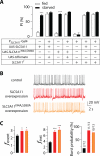Drosophila SLC5A11 Mediates Hunger by Regulating K(+) Channel Activity
- PMID: 27397890
- PMCID: PMC4980193
- DOI: 10.1016/j.cub.2016.05.076
Drosophila SLC5A11 Mediates Hunger by Regulating K(+) Channel Activity
Erratum in
-
Drosophila SLC5A11 Mediates Hunger by Regulating K+ Channel Activity.Curr Biol. 2016 Sep 26;26(18):2550. doi: 10.1016/j.cub.2016.08.027. Epub 2016 Sep 26. Curr Biol. 2016. PMID: 27676293 Free PMC article. No abstract available.
Abstract
Hunger is a powerful drive that stimulates food intake. Yet, the mechanism that determines how the energy deficits that result in hunger are represented in the brain and promote feeding is not well understood. We previously described SLC5A11-a sodium/solute co-transporter-like-(or cupcake) in Drosophila melanogaster, which is required for the fly to select a nutritive sugar over a sweeter nonnutritive sugar after periods of food deprivation. SLC5A11 acts on approximately 12 pairs of ellipsoid body (EB) R4 neurons to trigger the selection of nutritive sugars, but the underlying mechanism is not understood. Here, we report that the excitability of SLC5A11-expressing EB R4 neurons increases dramatically during starvation and that this increase is abolished in the SLC5A11 mutation. Artificial activation of SLC5A11-expresssing neurons is sufficient to promote feeding and hunger-driven behaviors; silencing these neurons has the opposite effect. Notably, SLC5A11 transcript levels in the brain increase significantly when flies are starved and decrease shortly after starved flies are refed. Furthermore, expression of SLC5A11 is sufficient for promoting hunger-driven behaviors and enhancing the excitability of SLC5A11-expressing neurons. SLC5A11 inhibits the function of the Drosophila KCNQ potassium channel in a heterologous expression system. Accordingly, a knockdown of dKCNQ expression in SLC5A11-expressing neurons produces hunger-driven behaviors even in fed flies, mimicking the overexpression of SLC5A11. We propose that starvation increases SLC5A11 expression, which enhances the excitability of SLC5A11-expressing neurons by suppressing dKCNQ channels, thereby conferring the hunger state.
Copyright © 2016 Elsevier Ltd. All rights reserved.
Figures






Comment in
-
Neuroscience: Hunger Pangs in the Fly Brain.Curr Biol. 2016 Aug 8;26(15):R701-R703. doi: 10.1016/j.cub.2016.06.060. Curr Biol. 2016. PMID: 27505238
Similar articles
-
Taste-independent nutrient selection is mediated by a brain-specific Na+ /solute co-transporter in Drosophila.Nat Neurosci. 2013 May;16(5):526-8. doi: 10.1038/nn.3372. Epub 2013 Mar 31. Nat Neurosci. 2013. PMID: 23542692 Free PMC article.
-
A quantitative feeding assay in adult Drosophila reveals rapid modulation of food ingestion by its nutritional value.Mol Brain. 2015 Dec 21;8:87. doi: 10.1186/s13041-015-0179-x. Mol Brain. 2015. PMID: 26692189 Free PMC article.
-
A Subset of Serotonergic Neurons Evokes Hunger in Adult Drosophila.Curr Biol. 2015 Sep 21;25(18):2435-40. doi: 10.1016/j.cub.2015.08.005. Epub 2015 Sep 3. Curr Biol. 2015. PMID: 26344091
-
Neural basis of hunger-driven behaviour in Drosophila.Open Biol. 2019 Mar 29;9(3):180259. doi: 10.1098/rsob.180259. Open Biol. 2019. PMID: 30914005 Free PMC article. Review.
-
The genetics of type A potassium channels in Drosophila melanogaster.Cell Biol Int Rep. 1989 Dec;13(12):1127-32. doi: 10.1016/0309-1651(89)90026-x. Cell Biol Int Rep. 1989. PMID: 2517596 Review. No abstract available.
Cited by
-
Neuronal Mechanisms that Drive Organismal Aging Through the Lens of Perception.Annu Rev Physiol. 2020 Feb 10;82:227-249. doi: 10.1146/annurev-physiol-021119-034440. Epub 2019 Oct 21. Annu Rev Physiol. 2020. PMID: 31635526 Free PMC article. Review.
-
Assessing the cognitive status of Drosophila by the value-based feeding decision.NPJ Aging Mech Dis. 2021 Sep 15;7(1):24. doi: 10.1038/s41514-021-00075-6. NPJ Aging Mech Dis. 2021. PMID: 34526491 Free PMC article.
-
Molecular mechanism on autophagy associated cardiovascular dysfunction in Drosophila melanogaster.Front Cell Dev Biol. 2025 Mar 3;13:1512341. doi: 10.3389/fcell.2025.1512341. eCollection 2025. Front Cell Dev Biol. 2025. PMID: 40099194 Free PMC article. Review.
-
Of flies, mice and neural control of food intake: lessons to learn from both models.Curr Opin Neurobiol. 2022 Apr;73:102531. doi: 10.1016/j.conb.2022.102531. Epub 2022 Apr 4. Curr Opin Neurobiol. 2022. PMID: 35390643 Free PMC article. Review.
-
Epigenome-Wide Study Identified Methylation Sites Associated with the Risk of Obesity.Nutrients. 2021 Jun 9;13(6):1984. doi: 10.3390/nu13061984. Nutrients. 2021. PMID: 34207686 Free PMC article.
References
-
- Cannon WB. The wisdom of the body. W.W. Norton & Company, Inc; New York, NY: 1939.
-
- Morton GJ, Cummings DE, Baskin DG, Barsh GS, Schwartz MW. Central nervous system control of food intake and body weight. Nature. 2006;443:289–295. - PubMed
-
- Adolph EF. Urges to eat and drink in rats. The American journal of physiology. 1947;151:110–125. - PubMed
-
- Dethier VG. The Hungry Fly. Harvard University Press; Cambridge, MA: 1976.
Publication types
MeSH terms
Substances
Grants and funding
LinkOut - more resources
Full Text Sources
Other Literature Sources
Molecular Biology Databases

